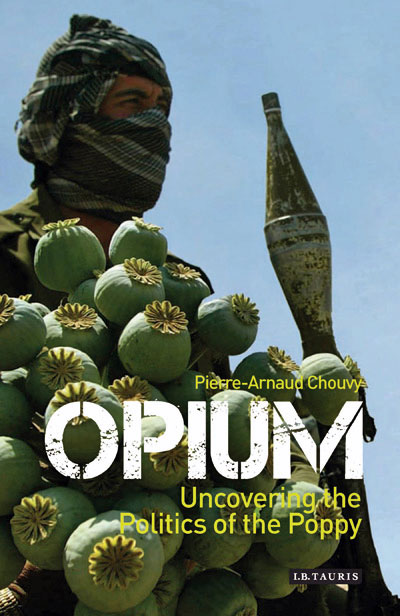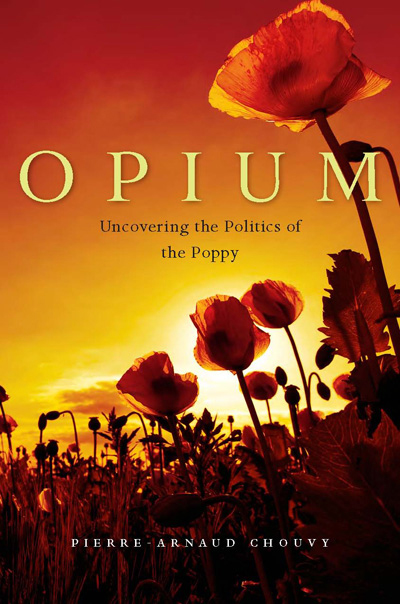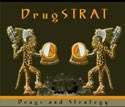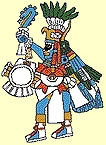Opium
Uncovering the Politics of the Poppy
Pierre-Arnaud Chouvy*
I.B. Tauris
London, October 2009
ISBN: 978-1-84511-973-7

Cover photograph: Armed Afghan policeman sits with confiscated opium poppies during a poppy eradication sweep of a farmer’s field in the village of Karezaq, outside Kandahar in southern Afghanistan. Photograph by David Guttenfelder (AP).
Harvard University Press
Cambridge, Mas., Spring 2010
(ISBN pending)

Endorsements:
‘Drawing on his deep, unequalled understanding of the political economy of illicit drugs, Pierre-Arnaud Chouvy has produced an exemplary study of the complex forces driving illicit narcotics production in the Golden Triangle and Golden Crescent regions of Asia. Through careful analysis of the historical, economic and ecological forces behind the rapid growth of illicit drug production in Central and Southeast Asia, Chouvy shows how and why the coercive crop eradication schemes favoured by the United States and United Nations have failed in the past and will fail again in the future. His evidence is unassailable and his argument is compelling. The social costs of forty years of failed “drug wars” have been high and the gains precious few. After a full century of failed drug prohibition, 1909 to 2009, Chouvy makes a persuasive case for an alternative approach.’
Alfred W. McCoy
Professor of History at the University of Wisconsin-Madison, author of The Politics of Heroin
‘This book establishes Pierre-Arnaud Chouvy as the successor to Alfred McCoy: he not only deciphers the long history of the opium poppy and the complex geopolitics of illicit drugs in Asia but also explains how and why decades of a costly “war on drugs” have failed.’
Alain Labrousse
Former Director of Geopolitical Drug Watch (Observatoire géopolitique des drogues), author of Afghanistan. Opium de guerre, opium de paix
‘How is it that after nearly a century of concerted international efforts by most of the major global powers, the illicit trade in heroin and opium has continued to grow? Chouvy’s fascinating and well-documented study of the politics of the poppy in Asia exposes the many dimensions of this issue. He follows the shifting tides of global politics, the Cold War and the twisted politics of failed states to show the manner in which agents of the US government and other states play against one another to seek “higher goals” while paving the way for shadowy drug lords, corrupt politicians and generals to expand their profits. At the same time, at home, the governments of the US, the European states and others pursue draconian policies in their wars on drugs.’
Carl A. Trocki
Professor of Asian Studies, Queensland University of Technology, author of Opium, Empire and the Global Political Economy
Introduction
Bitter, brownish, and sticky, opium – the sap of the opium poppy, Papaver somniferum Linnaeus – is an addictive narcotic drug known since the earliest times. Both a palliative and a poison, the exotic origins of opium and the properties that were frequently, if erroneously, attributed to it, have ensured the West’s continuing fascination and the aura of mystery that has long surrounded it.
My concern in this book is the politics and economics of the poppy in Asia, about how, when and why illicit opium production emerged and developed in specific regions of the continent at given periods of history. Its main objective is to explain how and why decades of anti-drug policies have not only failed to achieve their ultimate goal of suppressing illicit opium production but have even failed to reduce it.
The failure of more than a century of prohibition of certain drugs – opium included – is now evident. In fact, one hundred years of global prohibition and about forty years of a US-led War on Drugs have not just failed to suppress illicit opium production: for an increasing number of countries it seems likely to have both stimulated and displaced production.
In 1906, Charles Henry Brent, the first Protestant Episcopal Church Bishop of the Philippines and a staunch opponent of the then booming opium trade, wrote to President Theodore Roosevelt asking that the United States call for an international conference to enforce anti-opium measures in China. The same year, 41,624 tonnes of opium were produced worldwide: 85 per cent in China (35,364 tonnes) and 12 per cent in British India (5,177 tonnes). Opium had long been produced in Asia, most notably by the Mughal rulers of India, and its production, trade and consumption had been banned at different times in various countries, especially in the Chinese Empire (first in 1729). But in the mid-nineteenth century the British imposed their trade in Indian opium upon China through two so-called Opium Wars (1839-42 and 1856-60). This legalisation of the opium trade, imposed upon China by the British with the signing of the Treaty of Tianjin (1858), led eventually to the development of huge Chinese production: China had no choice but to promote an import substitution programme in order to address the deficit in its balance of payments with British India. Yet, in 1906 the Qing government of China launched its first national anti-opium campaign, one year before the British and Chinese governments agreed on a scheduled reduction of the opium trade. In 1909, the United States convened the International Opium Commission in Shanghai and in 1912 the Hague Convention urged its members to limit opiates to medical uses. Thus, less than sixty years after the Treaty of Tianjin legalized the Chinese import of British opium, opium production was on its way to becoming illicit except for medical purposes. This first step toward a global prohibition of certain drugs would prove successful, but only initially since the suppression of opium production in China and India eventually stimulated the emergence of illicit production in other areas, notably the so-called Golden Triangle and Golden Crescent areas of Southeast and Southwest Asia.
Following the multilateral efforts of the League of Nations (1919-46), then of the United Nations (founded in 1945), and after the Communist government in Beijing succeeded in eliminating opium production in China during the period 1949-59, global illicit opium output fell dramatically — to as little as 1,066 tonnes in 1970 (US government sources: McCoy, 1991: 495). But as world production was drastically reduced, so the areas where the opium poppy thrived changed. South of the recently opium-free China, a major new opium producing region emerged: Mainland Southeast Asia’s so called Golden Triangle. By 1970, 67 per cent of the world’s illicit opium was harvested in the Golden Triangle, with 23 per cent in the other emerging area: the Golden Crescent. Burma, in the Golden Triangle, alone contributed 47 per cent of the total; Afghanistan, in the Golden Crescent, a mere 10 per cent. Ironically, despite the fact that the world’s illicit opium production was at its lowest in 1970, the following year saw both the expression ‘Golden Triangle’ coined by a US official and the launch of a global War on Drugs by Richard Nixon’s administration. But this reduction in global production was short-lived and was mainly the result of the rapid suppression of production in China and India rather than an efficient global prohibition regime. In fact, many argue, as does this book, that the highly repressive War on Drugs proved not only inefficient but also counterproductive. Subsequent development-based policies, which were designed in the early 1970s, would also fail to drive illicit opium production down.
What is undeniable is that between the low of 1970 and the year 1989, illicit worldwide production of opium increased by 218 per cent to 3,395 tonnes (UNODCCP, 2001: 60) and that a marked change in the relative importance of producing countries took place. In 1989, Burma, whose many complex internal conflicts had stimulated opium production, was still the world’s leading illicit producer of opium. In fact, Burma’s output in 1989 exceeded the total world output for 1970, with 1,544 tonnes or 45 per cent of the global illicit output. But a challenger to world supremacy emerged to the west of the Himalayas: Afghanistan. Afghanistan’s opium output increased 800 per cent in thirty years (from 130 tonnes in 1970 to 1,200 tonnes in 1989) and represented 35 per cent of the total world output for 1989. Alone, in 1989 Afghanistan was producing more opium than the entire world had done in 1970. At the close of the 1980s, the Golden Triangle and the Golden Crescent together supplied 96 per cent of the world’s illicit opium — a percentage that has remained virtually unchanged into the 2000s.
Despite increased international and national anti-drug efforts, and despite a much better understanding of the dynamics of the global illegal drug markets and of the shortcomings of anti-drug policies and programmes, not much has changed since 1989 and global illicit opium production continues to increase. The only thing that has changed, especially since the mid- and late 1990s, is the relative size and breakdown of production figures. While Thailand, Vietnam and Pakistan drastically reduced their opium output, production has boomed in Burma and Afghanistan. Burma remained the world’s premier producer of illicit opium until 1991 (1,728 tonnes), when it was (just) overtaken by Afghanistan (1,980 tonnes). Then, in a matter of a few years, Afghanistan’s opium output snowballed, breaking record after record (3,416 tonnes in 1994, 4,565 tonnes in 1999 and 6,100 tonnes in 2006) and in 2007 its huge 8,200-tonne opium crop reportedly amounted to 93 per cent of the global output. In 2007, Afghanistan produced more opium than the entire world had done in 2006 (6,610 tonnes).
The steady increase in global opium production since the early 1970s has occurred despite the many efforts by the international community to suppress or reduce illegal opium poppy cultivation worldwide. Countless forced eradication campaigns, and many crop substitution and alternative development programmes, have failed. It can even be argued, as is done in this book, that forced eradication campaigns have been counterproductive, causing – at least to some extent – an increase in illicit opium production. Of course, the reasons for such a global failure are many and complex, rooted in the long history and politics of Asia and of the poppy. Opium production has clearly benefited from the turmoil of Asian history and geopolitics. The nineteenth-century Opium Wars, the twentieth-century Cold War and the many local conflicts waged by proxy in Burma, Laos, and Afghanistan, and even the twenty-first-century War on Terrorism in Afghanistan and Pakistan, have all fuelled the continent’s illicit opium production. Illicit drug economies and war economies share a long and common history and have shared many territories in Asia and elsewhere.
Yet, illicit opium production has benefited not only from synergies between war economies and drug economies: it has also thrived on economic underdevelopment and poverty, whether war-induced or not. It is now widely acknowledged that the vast majority of Asian opium farmers grow poppies in order to combat poverty and, above all, food insecurity. Despite this fact (and the vast majority of Asian opium farmers are among the poorest of the poor), many observers and policy makers still doubt that farmers engage in illegal opium production out of need — and not out of greed. In 2007, even the United Nations Office on Drugs and Crime bluntly argued that Afghan opium production was not linked to poverty — ‘much to the contrary’. In fact, history and geography show that illicit opium production never thrives better than when war and poverty overlap, as in Afghanistan and Burma. Part of the problem, in both Afghanistan and Burma, is that illicit opium production largely outlasts war. War often transforms political and economic realities and time is needed for war-torn countries to achieve the transition from war economy to peace economy. In predominantly rural countries such as Afghanistan and Burma, where conflict has lasted for decades and hampered economic growth and development, it seems that the suppression of illicit opium production can only proceed from the establishment of peace and the initial reconstruction of the state and of the economy.
But opium suppression policies have also failed because they have been – for the most part – inadequate, ill-funded, and improperly sequenced. In spite of three international ‘conventions on narcotic drugs’ (1961, 1971, 1988), the launch in 1971 of a global War on Drugs by the United States, and the creation of a specialized anti-drug body within the United Nations (UNFDAC: 1972; UNDCP: 1991; UNODC: 2002), the ‘Drug Free World’ proclaimed by the motto of the UN anti-drug agency has proved an elusive goal.
The politics favouring poppy cultivation have proven considerably more successful than the policies designed and implemented in order to ban it. Neither the War on Drugs nor development approaches have reduced illicit opium production in Asia — quite the opposite. Why have anti-drug policies failed despite four decades of continuing and increasing effort? What are the shortcomings and limitations of forced eradication, alternative development, ‘silver bullets’ and other ‘quick fixes’? The following pages will attempt to provides answers to these and other questions and in doing so it will be necessary to call upon a rich and extensive literature that includes the disciplines of history, geography, anthropology, politics, agronomy and development. Such is the great diversity and complexity of illicit opium production in Asia.
The first half of the book (chapters 1 to 5), draws on the complex history and geopolitics of the opium poppy in Asia, from Neolithic times to the mid-twentieth-century emergence of the Golden Triangle and the Golden Crescent, to the most recent developments in opium production in Afghanistan and Burma. How, where and when did illicit opium production take place in Asia? Who contributed to the emergence of the Golden Triangle and the Golden Crescent, and why? How and where did opium and heroin trafficking occur? Chapters 1 to 5 give a detailed overview of the roots and dynamics of illicit opium production and of drug trafficking in both the Golden Triangle and the Golden Crescent.
The following chapters first detail and explain how and why illicit opium production thrived in certain regions and countries of Asia and not in others. What relations existed and still exist between war and drugs, between war economies and drug economies? Did illicit opium production finance terrorism or did the strategic imperatives of the War on Terrorism put the War on Drugs on hold?
Alongside such geopolitical and geostrategic considerations, this book also offers a detailed look at the diversity and complexity of the agricultural and economic contexts of opium poppy cultivation in both Southeast and Southwest Asia. How and why is opium production undertaken in Asia, and by whom? Why do some Asian farmers resort to illicit opium production in spite of its labour intensiveness and poor economic yield? Understanding the ‘drivers’ of opium poppy cultivation and the motivations of opium farmers is a prerequisite to understanding the reasons for the successes and failures of anti-drug policies. How and why did forty years of forced eradication, crop substitution, and alternative development programmes not only fail to suppress illicit opium production but even to hamper its growth? In conclusion the book details and analyses the shortcomings, insufficiencies, and potentialities of anti-drug policies by reviewing the anti-drug history of Asia’s opium producing countries.
* Pierre-Arnaud Chouvy is research fellow at the French National Centre for Scientific Research (CNRS). A geographer and a specialist of Asia, he is one of the world's foremost experts on the production and trade in illicit opiates. Chouvy has authored many papers and two books, Les territoires de l'opium. Conflits et trafics du Triangle d'Or et du Croissant d'Or (Olizane 2002) and Yaa Baa: Production, Traffic and Consumption of Methamphetamine in Mainland Southeast Asia (Singapore University Press 2004). His writings and photographs are posted on Geopium.org.

